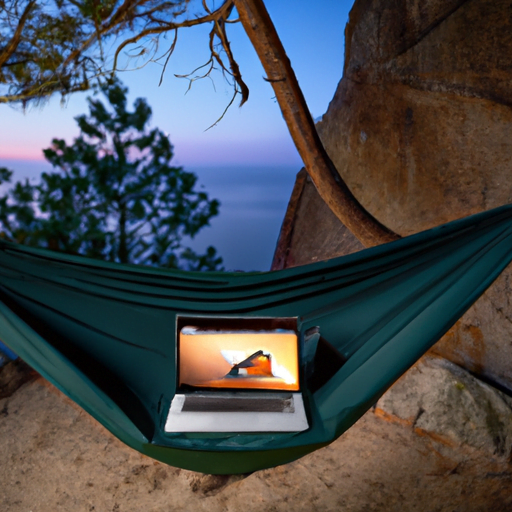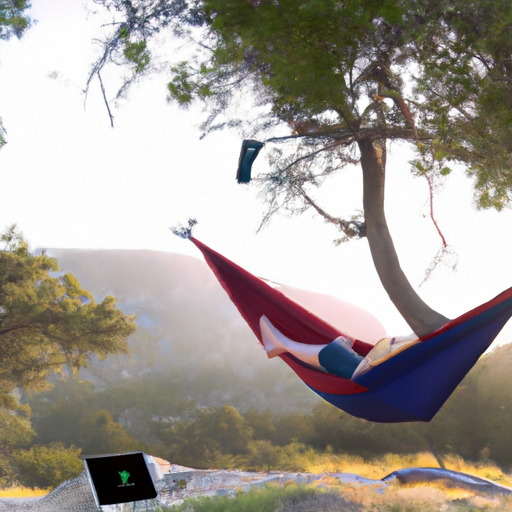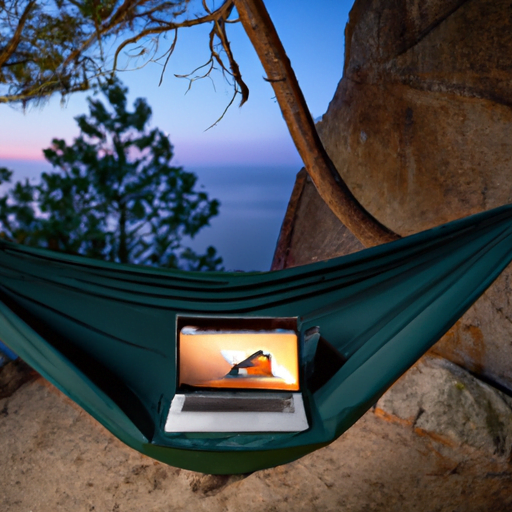Have you ever gone camping and found yourself longing for a strong WiFi signal? In today’s digitally connected world, it’s not surprising that many of us want to stay connected even while enjoying the great outdoors. Whether it’s for work, keeping in touch with family and friends, or simply streaming your favorite shows, having access to WiFi can enhance your camping experience. But how exactly can you get WiFi while camping? In this ultimate guide, we will explore various methods and solutions to ensure you stay connected even in the remotest of camping locations.
One of the first things to consider when trying to get WiFi while camping is the concept of off-grid living. This refers to living or camping in an area without access to traditional infrastructure such as electricity, water, and in our case, WiFi. However, thanks to rapid technological advancements, it is now possible to bring the comforts of modern connectivity to even the most remote camping spots. From portable WiFi routers to satellite internet, there are several options available that can provide you with a reliable internet connection regardless of your location.
In this guide, we will delve into the different methods of getting WiFi while camping, from creating your own hotspot with a mobile hotspot device or your smartphone, to using campground WiFi or external antennas to enhance signal strength. We will also discuss the importance of considering data limits and network coverage, as well as provide helpful tips on optimizing your WiFi connection. Whether you’re a seasoned camper or planning your first camping trip, this ultimate guide will equip you with the knowledge and tools you need to stay connected while enjoying the wonders of nature. So let’s dive in and discover the world of getting WiFi while camping.

The Ultimate Guide to Getting WiFi While Camping
When it comes to camping, one of the biggest challenges can be staying connected to the digital world. Whether you need to work remotely, stay in touch with loved ones, or simply stay entertained during downtime, having a reliable internet connection is essential. In this ultimate guide, we will explore various methods to get WiFi while camping, ensuring that you can stay connected no matter where you are.
Researching Campground Options
Before heading out on your camping trip, it’s important to research the campground options available to you. Not all campgrounds offer WiFi, so this step is crucial in ensuring that you have internet access during your stay. Many campgrounds now provide this amenity, but it’s always best to double-check their website or call ahead to confirm.
Checking for WiFi Availability
Once you have chosen a campground, it’s time to check if they offer WiFi and what the coverage is like. Some campgrounds may only offer WiFi near the main office or communal areas, while others may have WiFi throughout the entire campground. Checking for WiFi availability will help you plan ahead and determine where you need to position yourself to get the best signal.
Considering Cell Signal Strength
In cases where the campground does not offer WiFi or the coverage is limited, relying on cell signal strength may be your next option. Before packing your bags, check the coverage maps of different cell service providers in the area. This will give you an idea of which provider has the best signal strength in the campground area. It’s also a good idea to invest in a smartphone with an external antenna port or an external antenna adapter, as this can significantly improve your signal reception.
Using Mobile Hotspots
If there is no WiFi available or the signal is weak, using a mobile hotspot can be a great solution. Mobile hotspots are portable devices that connect to cellular networks and create a WiFi network that you can connect your devices to. They usually require a data plan with a specific amount of data allowance.
Understanding Mobile Hotspots
Mobile hotspots work by connecting to a cellular network, just like your smartphone. They amplify the signal and convert it into a WiFi signal that multiple devices can connect to. This allows you to use the internet on your laptop, tablet, or any other device that requires WiFi.
Selecting the Right Mobile Hotspot Plan
When choosing a mobile hotspot plan, it’s important to consider how much data you will need during your camping trip. Some plans offer a specific amount of data per month, while others offer unlimited data. Keep in mind that unlimited data plans may have a fair usage policy that can slow down your internet speed after a certain amount of data usage. Carefully evaluate your usage needs and choose a plan that suits your requirements.
Setting Up and Using a Mobile Hotspot
Setting up a mobile hotspot is usually a simple process. Just turn on the device, enter the provided password on your device’s WiFi settings, and you should be connected. However, make sure to follow the manufacturer’s instructions for your specific device. Once connected, you can use the internet as you would with any other WiFi network.
Boosting Cell Signal Strength
If you find yourself in an area with weak cell signal, there are several steps you can take to boost your signal strength and improve your internet connection.
Identifying Weak Signal Areas
The first step in boosting cell signal strength is to identify the areas with weak signal. Walk around your campsite with your smartphone or other devices and observe the signal strength bars. Note down the areas where the signal is weak, as these are the areas where you will need to focus your signal boosting efforts.
Using a Signal Booster
A signal booster, also known as a cellular repeater, is a device that captures the existing weak signal and amplifies it to create a stronger and more reliable signal. Signal boosters consist of an external antenna that captures the weak signal, an amplifier that boosts the signal, and an internal antenna that broadcasts the amplified signal within a designated area. Installing a signal booster can significantly improve your signal strength and internet connection while camping.
Optimizing Antenna Placement
When using a signal booster, antenna placement is crucial for optimal signal reception and amplification. The external antenna should be placed in a location where it can capture the best possible signal. This may require experimentation and moving the antenna to different locations until you find the sweet spot. Keep in mind that the internal antenna should be placed in a central location to ensure equal signal distribution throughout the designated area.

Using WiFi Extenders
In cases where the campground offers WiFi but the signal is weak in certain areas, using a WiFi extender can help improve the signal strength and extend the coverage area.
Understanding WiFi Extenders
A WiFi extender, also known as a WiFi booster or repeater, works by receiving the existing WiFi signal and amplifying it to provide a stronger and more reliable signal. It essentially acts as a bridge between your device and the original WiFi source, extending the coverage area and improving the signal strength.
Choosing the Right WiFi Extender
When choosing a WiFi extender, consider factors such as the range you need to cover and the strength of the original WiFi signal. Look for a WiFi extender that is compatible with your existing WiFi setup and offers features such as dual-band support and easy setup.
Setting Up and Configuring a WiFi Extender
Setting up a WiFi extender typically involves connecting it to your existing WiFi network. Follow the manufacturer’s instructions for your specific device to ensure a seamless setup process. Once configured, the WiFi extender will create a new network that extends the coverage area of your original WiFi.
Utilizing Satellite Internet
In remote areas where there is no cellular or WiFi coverage, satellite internet can be a viable option to get internet access while camping. However, it is important to note that satellite internet may require additional equipment and can be more expensive than other methods.
Exploring Satellite Internet Options
There are several satellite internet providers that offer services specifically designed for outdoor enthusiasts. These services typically consist of a satellite dish or portable satellite terminal that connects to a constellation of satellites orbiting the Earth.
Evaluating Data Plans
When choosing a satellite internet provider, it’s important to evaluate their data plans and consider factors such as data allowances, speed, and pricing. Since satellite internet can be more expensive than other methods, it’s crucial to choose a plan that fits your budget and usage requirements.
Installing and Accessing Satellite Internet
Installing satellite internet usually involves setting up the satellite dish or portable terminal in a location with a clear view of the sky. Once installed, you will need to configure the device and connect your devices to the provided WiFi network. Keep in mind that satellite internet can have higher latency due to the long distance the signals travel, so it may not be suitable for activities that require real-time communication or online gaming.
Connecting to Nearby Public WiFi
If you prefer not to rely on your own internet connection, connecting to nearby public WiFi networks can be a convenient option. Many public places such as coffee shops, libraries, and restaurants offer free WiFi access to their customers.
Identifying Nearby Public WiFi Networks
To find nearby public WiFi networks, you can use your smartphone, tablet, or laptop to scan for available networks. Look for places in the vicinity that may offer WiFi, and check if they have any requirements such as password authentication or agreement to terms and conditions.
Securing Your Connection
Using public WiFi networks can pose security risks, as they are often unencrypted and expose your data to potential hackers. To protect your connection, avoid accessing sensitive information such as online banking or shopping, and consider using a VPN (Virtual Private Network) for added security.
Using VPN for Added Security
A VPN encrypts your internet traffic, making it more secure and protecting your data from potential threats. By using a VPN while connected to public WiFi, you can ensure that your online activities remain private and secure.
Creating a Personal WiFi Network
For those who prefer a more controlled and secure internet connection, creating a personal WiFi network can provide a reliable and private internet access solution while camping.
Setting Up a Personal WiFi Network
To set up a personal WiFi network, you will need a portable router that supports creating a WiFi network using a cellular data connection. These portable routers typically have a SIM card slot or USB port where you can insert a SIM card with a data plan.
Configuring a Router
Once you have your portable router and a data plan, follow the manufacturer’s instructions to configure the router. This usually involves inserting the SIM card, connecting to the router’s admin interface, and entering the necessary configuration settings provided by your cellular service provider.
Securing Your Personal WiFi Network
To ensure the security of your personal WiFi network, it’s important to set a strong password and enable encryption. This will prevent unauthorized users from accessing your network and potentially compromising your data.
Exploring Alternative Technologies
In addition to the aforementioned methods, there are several alternative technologies that you can explore to get WiFi while camping.
Using Mesh Network Systems
Mesh network systems consist of multiple devices that work together to create a WiFi network with extended coverage. These devices communicate with each other to create a seamless and robust network, making them ideal for larger camping setups or groups.
Trying MiFi Devices
MiFi devices, also known as portable WiFi hotspots, are compact devices that provide internet access by creating a WiFi network using a cellular data connection. They are similar to mobile hotspots but are typically smaller and more portable.
Considering Cellular Data Plans
If you have a smartphone with a good data plan, you can consider using it as a mobile hotspot to create a WiFi network. However, it’s important to check the terms and conditions of your data plan to ensure that it allows for hotspot usage without any limitations or additional charges.
Maximizing Battery Life
Whether you rely on a mobile hotspot, WiFi extender, or any other method to get WiFi while camping, maximizing battery life is crucial, especially in remote areas where power sources may be limited.
Conserving Battery Power
To conserve battery power, turn off any unnecessary features or apps on your devices that may drain the battery. Reduce the screen brightness, disable push notifications, and close any background apps that you’re not using.
Optimizing Device Settings
Optimizing your device settings can also help extend battery life. Lowering the screen timeout, enabling power-saving mode, and disabling unnecessary wireless connections when not in use are some effective ways to conserve battery power.
Investing in Portable Power Banks
In case you need to charge your devices on the go, investing in portable power banks can be a lifesaver. These compact devices store electrical energy that you can use to charge your smartphone, tablet, or other devices when an electrical outlet is not available.
Conclusion
Getting WiFi while camping is no longer a challenge with the multitude of options available. Whether you choose to rely on campground WiFi, use a mobile hotspot, boost cell signal strength, or explore alternative technologies, staying connected during your camping trip is within reach. By implementing the tips and techniques outlined in this ultimate guide, you can make the most out of your camping experience while staying connected to the digital world. So pack your bags, set up camp, and enjoy the great outdoors without sacrificing your internet connection.




